
MENUMENU
TALK TO AN EXPERT
Special Hours: 7AM – 6PM PST
TALK TO AN EXPERT
Special Hours: 7AM – 6PM PST
Solar panels atop RVs are all the rage. Everybody’s installing them. But what are RV solar panels? How do they work, what can they do for you, and are they worth the investment? Let’s find out!

In the 1800s, scientists observed something called the photovoltaic effect, where some materials would produce an electric charge and current when exposed to sunlight. Attempts were made over the years to create “solar engines,” as they called them, but most had very low efficiencies. It wasn’t until the 1950’s that scientists discovered that silicon (found in sand) could create a much more efficient solar panel.
This initial discovery led to the development of solar cells that could harness the sun’s energy and turn it into electricity. The technology has evolved over the years, but the concept remains the same.
A solar panel is a panel filled with solar cells that capture the sun’s energy and turn that energy into usable electricity that powers homes, businesses, coffee pots, and, yes – your RV!
Let’s find out how it all works!

Let’s imagine you have a couple of solar panels on the roof of your RV. If your RV is on the road or parked during the day, sunlight hits your solar panels, and cells on the panels absorb energy from the sun.
Within your solar panels’ cells, circuits take the energy absorbed by the sun’s cells and turn it into electrical current. The electrical current is fed through wires to a charge controller that controls the battery’s current.
So the system looks like this:

This energy becomes DC (direct current) electricity that charges your RV’s house battery or batteries, essentially “storing” energy to be used to power devices and appliances in your RV or charge devices for your later use.
This DC power from the solar panels and batteries is typically 12 volts. This DC power runs lights, appliances, and electronics in the RV.
However, you can also take that 12-Volt DC, pass it through an inverter, and convert it to 120-Volt AC (alternating current) electricity (like the outlets found in a sticks-and-bricks house) to power 120-Volt devices such as a coffee pot.
There are 120-Volt outlets scattered throughout your RV, but those don’t have power unless you’re using a generator or your RV is plugged into shore power.
If you want to run a 120-Volt appliance when you’re boondocking in the desert, you can harness the sun’s energy through solar panels —> charge controller —> batteries —> inverter, and voila! = 120-Volt electricity at your command!

Theoretically, you can power anything with the sun’s energy provided you have enough solar panels, batteries, and conversion ability!
Knowing how much solar power you need for your camping comfort involves figuring out a couple of pieces of information. These two parts of the equation help you determine how many solar panels you’ll need for the sun’s power to deliver the electricity you want. The two parts of this equation are:
You must balance all of this for an optimal system. Solar panels without enough batteries to store all of the power they produce will waste your money and not provide the power you need.
Conversely, one solar panel and lots of batteries will not allow enough of the sun’s energy to be harnessed to fill those batteries for your use!

Figuring out this balancing act can take some work and requires an entire article of its own to explain, but we can distill down the basics here.
First, you need to know how much energy you use in a day. There are a couple of ways you can do this. The first involves math. Estimate how much power you’ll consume while boondocking in your RV by learning what each device or appliance you want to use consumes and multiplying that by the number of hours you’ll use that device or appliance.
Here’s an example: You have one television that consumes 90 Watts. You estimate that you’ll watch television for approximately two hours per day. So 90W x 2h = 180 Watt/Hours per day
You can do the same for every appliance or device you may want to power as you boondock, and you would add the total of Watt-hours consumed. From there, you can estimate how many panels you need.
A decent assumption is that a 100-Watt solar panel will generate on average 350 Watt-hours of power per day. However, this will vary significantly by location and time of year. This article by Mortons on the Move explains a way to get a more accurate result by using PVwatts.
You’ll also need to know how many batteries you’ll need to store that amount of power! One 100 ah 12volt Battle Born battery has about 1200 Watt-hours storage capacity.

Keep in mind that your solar panels will only give you the stated number of Watts under perfect conditions. Perfect conditions = direct sun pointing directly at the panel. On a rainy day, you won’t get 100 Watts from your 100-Watt solar panel. If you’re parking in the shade, you won’t get 200 Watts from your 200-Watt solar panel.
It’s also challenging to estimate the amount of power you’ll use on a given day because days are different. You may be outside all day today enjoying nature, and fall into bed and watch 15 minutes of television tonight. Tomorrow could be a rainy day, and you’ll stay inside your RV, do a lot of work on your laptop, and watch a couple of hours of television in the evening. So estimating high is usually a good idea!
Rather than estimating your daily power consumption using math, some people prefer to simply go out camping without electrical hookups and monitor their battery usage over a typical day. Installing a battery meter like the Victron BMV712 before installing solar can give you an accurate reading of how much power your RV needs.
Before we take a look at how you install a solar system, let’s review the RV solar system components:
Your battery bank is the heart of an RV’s power system. Without a battery, an RV has no way to store power. The battery is where energy provided by the sun is stored for your use. Your solar panels will charge the battery bank.
But not all battery banks are created equal, and not all are suited to the unpredictable charge cycles of solar systems. Lithium batteries for solar applications are the superior choice over lead-acid.
Read The Truth About Lead-Acid Vs. Lithium-ion Batteries to understand the differences.

Your RV solar panels will sit on the roof of your RV collecting energy from the sun in the solar cells and transferring that energy (through a charge controller) to your battery bank. Your solar panels may lay flat, or you may choose to employ a mounting method that allows you to angle the solar panels toward the sun.

The charge controller mounts inside the RV. Wires run from your solar panels to the charge controller and from the charge controller into your battery bank. The purpose of the charge controller is to control the rate at which your batteries charge. The charge controller is required to prevent overcharging and in the case of an MPPT charge controller, operate the panels as efficiently as possible.

The electricity from your batteries is 12-Volt DC electricity. With this, you can power all 12-Volt devices and appliances as well as the 12-Volt (cigarette lighter) ports in your RV. If you want to use 120-Volt AC electricity to power a coffee maker, laptop, Instapot, or anything that requires AC, you’ll need an inverter that transforms 12V DC power to 120V AC power.
You’ll mount your inverter inside your RV as close to your battery bank as possible, and your AC appliances and devices will receive the transformed (from DC to AC) power from that inverter.
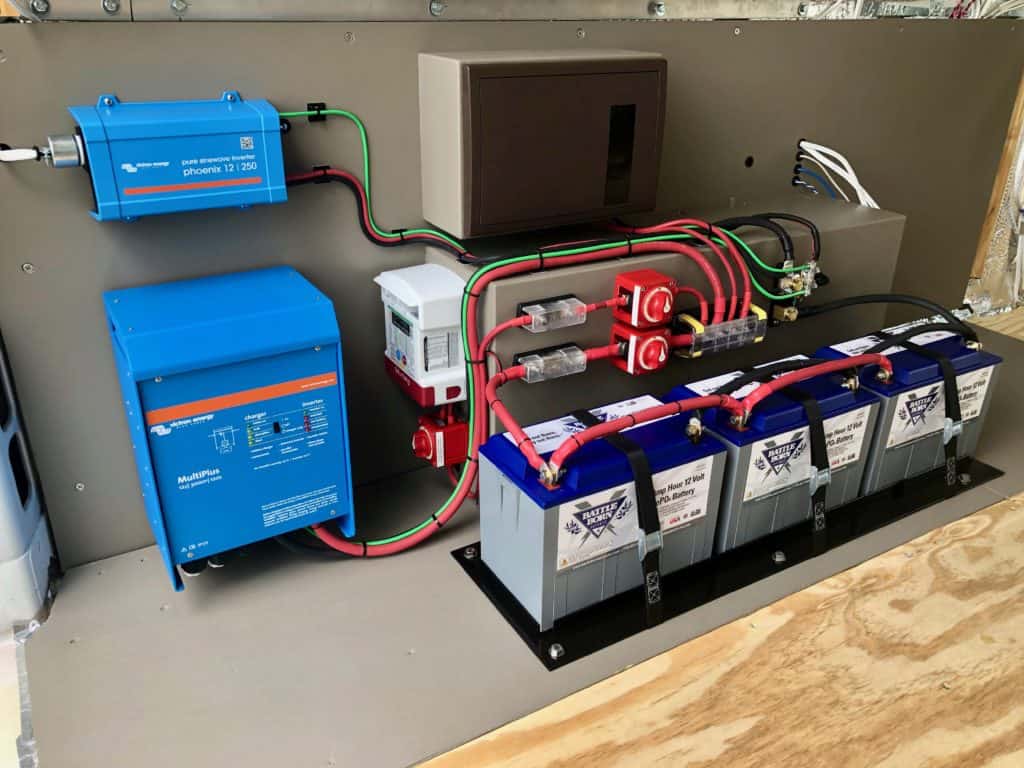
No! Any type of solar panel can be made to work with an RV; however, there may be some challenges.
First is space available. An RV roof may have lots of stuff on it and require the use of smaller panels. If the roof is wide open, full-size residential panels like used on homes can be used for RV solar panels.
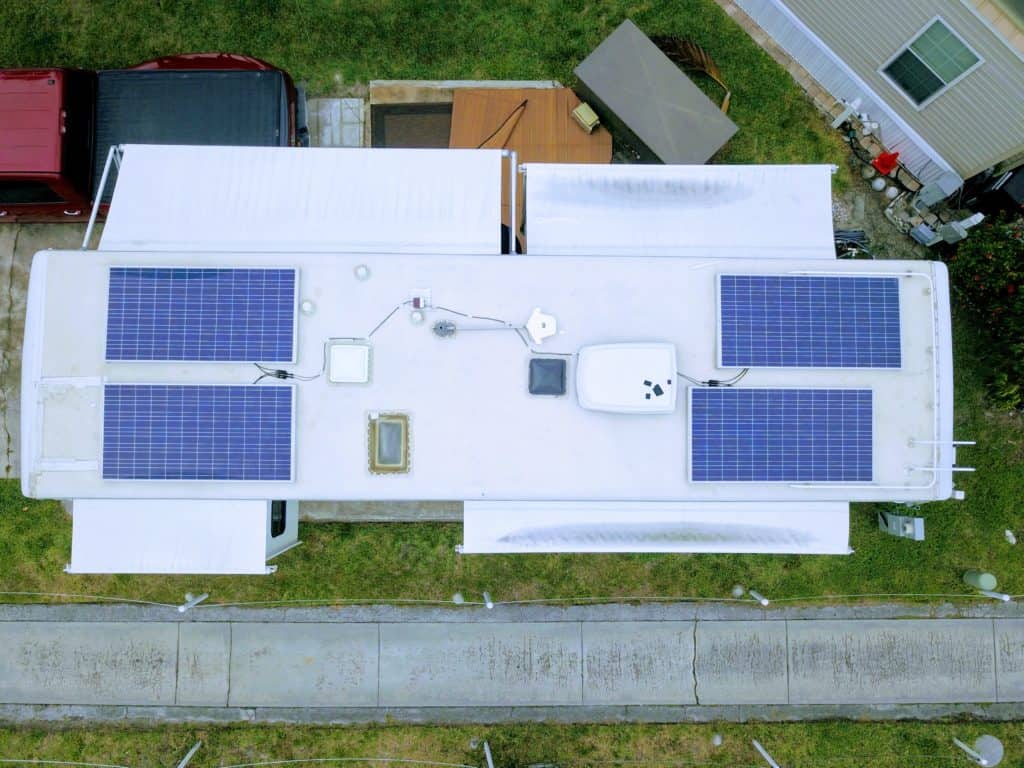
The second challenge with non-RV-specific panels is the voltage they operate at. Most RV solar panels are around 17-20 volts which will work with most PWM charge controllers to charge a 12-volt system. Home solar panels are usually 40-70 volts and cannot be used with PWM charge controllers.
You can use MPPT style controllers as long as they have a high enough voltage rating. Using an MPPT controller allows the use of most of any solar panel for an RV.
Now that we know how many solar panels you want to add to your RV let’s figure out how to connect them to your RV batteries to produce the electricity you need!
Solar electric systems for RV’s vary enormously, especially if installing a larger system, make sure you are confident working with electrical wiring before taking this on. For systems up to a few hundred watts or kits, the voltages are not dangerous and can be installed by anyone. Regardless of the size, the following instructions are a high level of how the components should be wired.
Let’s assume that you’ve purchased a kit containing the solar panel system parts, and you have a battery or battery bank installed in your RV.
Your kit will contain:

You may also want a battery monitor and an inverter (to turn that 12V DC power into 120V AC power).
Here are the steps to connecting your solar panels to your batteries:

Note: If you are wiring your solar panels/controller directly to your battery bank, there is no need to disconnect the existing converter in your RV. Both the converter and the solar panels will be able to supply charge to the battery bank.
If you always camp at campgrounds and RV resorts where you will be paying for electrical hookups to power your RV and your various devices and appliances, then investing in a solar system may not be worthwhile.

However, if you like to boondock – to stay in areas where there are no electrical hookups – beaches, city parks, state parks, the desert, a solar panel system is an excellent addition to your RV lifestyle. Solar panels provide silent power and can minimize the need for a noisy generator to recharge your batteries.
Solar panels are a remarkable development in renewable energy! As an RVer, a solar panel system frees you! It allows you to go anywhere and stay anywhere, harnessing the incredible power of the sun to address all of your electrical needs.
We know that building or upgrading an electrical system can be overwhelming, so we’re here to help. Our Reno, Nevada-based sales and customer service team is standing by at (855) 292-2831 to take your questions!
Also, join us on Facebook, Instagram, and YouTube to learn more about how lithium battery systems can power your lifestyle, see how others have built their systems, and gain the confidence to get out there and stay out there.
Shop Best Sellers

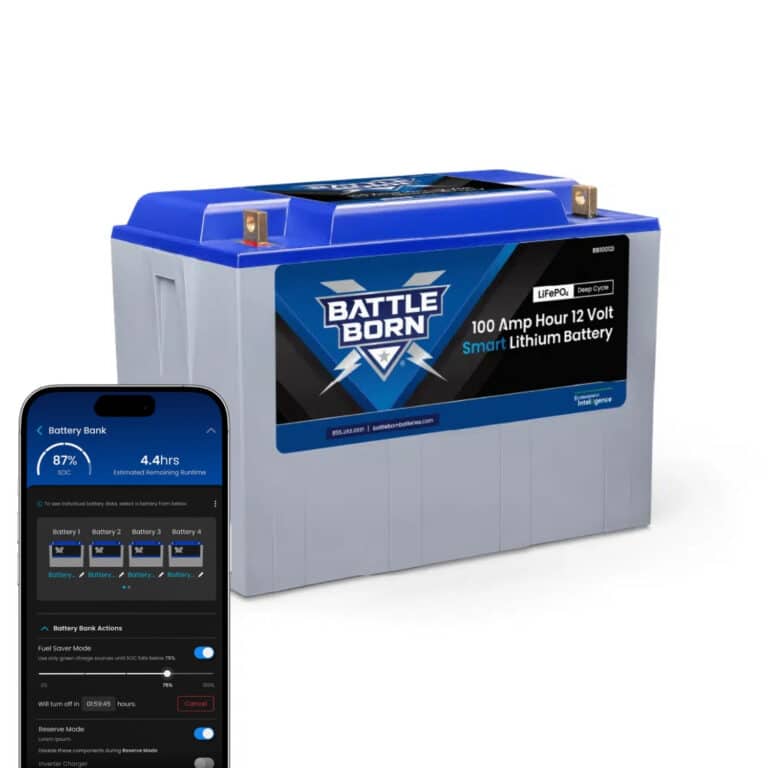

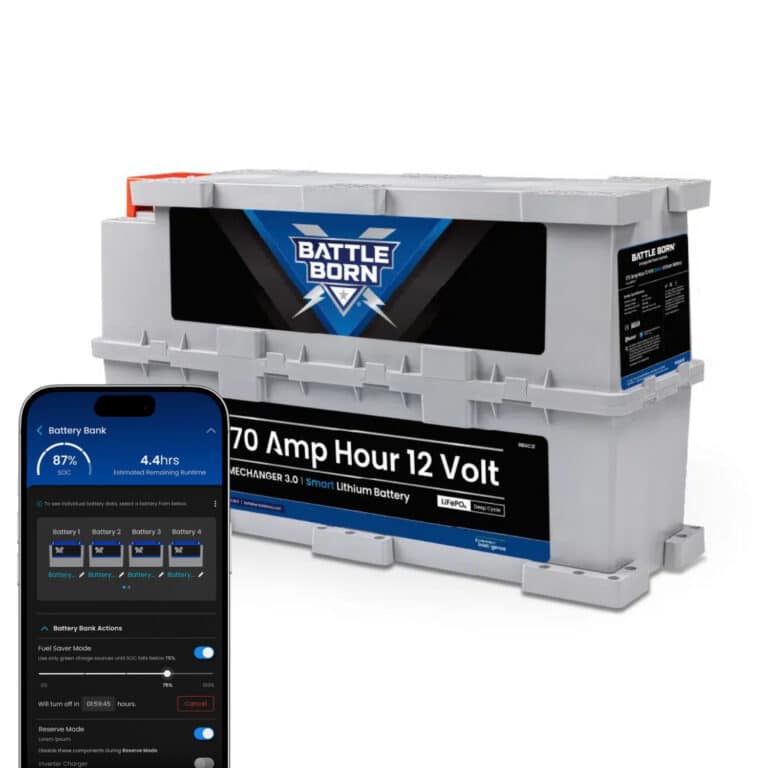



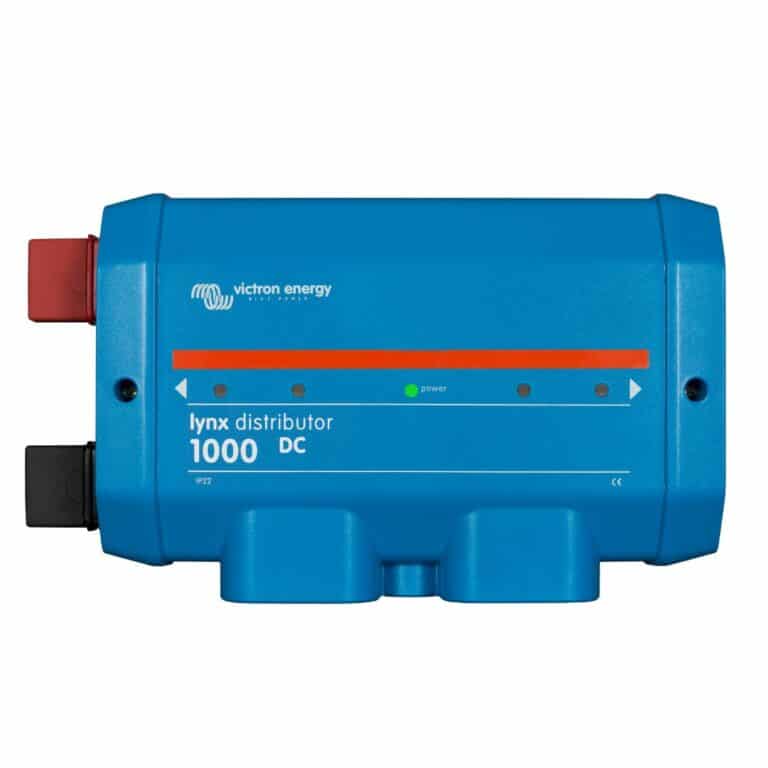
Ask a technical specialist now at 855.292.2831
Stay in the Know
24 thoughts on “RV Solar Panels: A Guide For Beginners”
Travel trailers are designed to charge the battery while connected to 120 VAC. Will that work ok with LiFePO4 batteries?
Hi Larry, our batteries can work with travel trailers, please check out our section on all things towable here: https://battlebornbatteries.com/learn/applications/rv/
Travel trailers are designed to charge the battery while connected to 120 VAC. Will that work ok with LiFePO4 batteries? If I use an inverter to produce AC won’t that power my battery charger? I guess what I am asking is will my AC-DC converter be in the way?
You will need a specific type of inverter.. an “inverter charger”. A simple inverter will not charge your batteries or sense 120vac coming in to turn off DC usage. Inverter/chargers, however, will charge your batteries while connected to shore power and will have 1 or more connections you can run Romex wire from for AC outlets.
I have caught many a trout wade fishing behind Tom’s rig. I was born and raised about 8 miles from there.
Who would we contact about buying and installing solar panels on our motor home? Also will solar panels run air conditioners in motor home?
Hi Nancy and Chris! That’s a great question. If you’d like to purchase our solar panels you can browse some of the options on our online store. We also have installers across the country and our team is always ready to give recommendations based on where you are located. As for your second question, we recently published a helpful blog that goes into detail about what solar panels can indeed run: https://battlebornbatteries.com/run-rv-ac-unit-on-lithium-batteries/
My is solar ready, what do I need for installation of a system?
Good morning Dan! Are you planning to install it yourself or go to a professional installer to do it? Our team has a lot of fantastic recommendations for installers across the country, so you can give our team a call at 855-292-2831.
I have a short skoolie (14′). I am looking at installing a solar array but I’m not sure of the cost. If I were to install 4 x 100w panels, a controller, an inverter, fuses & 4 lithium batteries, can you give me an idea of the costs without installation.
Hi Bruce, thanks for reaching out. If you give our technical sales team a call at 855-292-2831 they would be more than happy to help spec out your system and get you a quote on the price of it all.
When storing rv should I turn my battery off or leave it on and let solar panel keep battery topped off
If you leave it on, it will act as a trickle charger and keep your batteries topped off and ready for use.
How does the solar system interact with your onboard charger? They are connected to the same place on the battery correct?
This is a great guide for beginners! I’m new to solar panels and this has been very helpful.
This is a great guide for beginners! I’m new to solar panels and this has been very helpful.
I don’t have much storage space so can I place my lithium battery in my old battery case? I usually don’t camp below freezing temps.
If I shut down my camper completely and remove the batteries for the winter should I cover my solar panel? Do I need to do anything since the electricity generated by my solar panel has nowhere to go?
Hi! If you don’t have a shut-off or disconnect switch for your system and solar panels than yes, we would recommend covering up your solar panel.
IF i turn off the battery power, (battery disconnect as to not drain wgile ibn storage, will my solar panels continue to charge ? Do I need to leave battery connection on while in storage?
Hi Amy! We recommend bringing the Battle Born Batteries to a 100% charge and then disconnecting them completely for storage. The storage temperature range is -10°F to 140°F (-23°C to 60°C).
I am a 60 yr.old female.i live off of disability..I have a 31 ft.hornet travel trailer I live in..I want to get solar panels for my camper..it did not have a inverter in it when I purchased it..I would like to know how much it would cost to buy.all I need..I only use TV,a/c,2lights and microwave daily,also ini fridge,charge cell phone..I’m so afraid of getting ripped off what would be best option.some people say solar/invertor,some say portable power station/solar,some say power station/batteries ..I don’t know anything about any of it..I need the cheapest but reliable.im disabled and alone.
Hi Dorothy! Our technical sales team would love to assist you in configuring a system that suits your specific needs. You can reach them at (855) 292-2831 (M-F 8:00am – 4:30pm (PST) or by emailing [email protected]
This blog is an absolute gem. The author’s writing is not only informative and engaging, but also thought-provoking and insightful. I appreciate the level of research that goes into each post, and the author’s ability to present complex ideas in a clear and accessible way. What I love most about this blog is its commitment to providing factual and balanced perspectives on a wide range of topics. Whether I’m looking to learn something new or simply looking for an interesting read, I always turn to this blog.